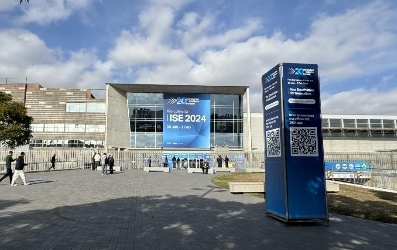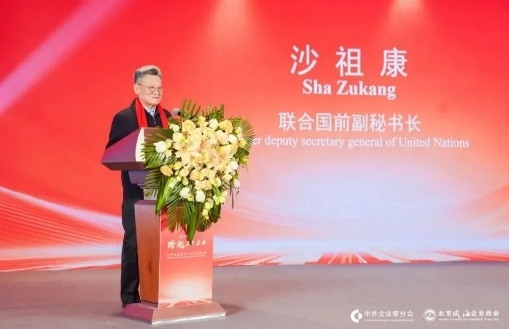By Lin Zhijia and Shaw Wan
BEIJING, December 26 (TMTPOST)Net energy gain is possible. U.S. scientists have managed to generate more energy from fusion reactions through shooting lasers at hydrogen atoms.
“[It is] the first time it has ever been done in a laboratory, anywhere in the world. Simply put, this is one of the most impressive scientific feeds of the 21st century,” said Jennifer Granholm, Secretary of the U.S. Department of Energy (DOE), on December 13.
According to the U.S. DOE and the National Nuclear Security Administration, the National Ignition Facility (NIF) at the Lawrence Livermore National Laboratory(LLNL) in California used 192 laser beams to deliver 2.05 megajoules of energy to a tiny fuel particle to produce fusion ignition. They created 3.15 megajoules of fusion energy, a net gain of over 1.5 times.
This achievement is a long-awaited milestone, as scientists have been working for over 70 years for it. It means unlimited and zero-carbon energy through a nuclear fusion power plant is possible, especially in an age troubled with global energy shortages and climate change brought by burning fossil fuels.
“The ignition device in the U.S. input laser energy and output fusion energy. Its successful because it generated more energy than the input. Theyve made progress,” a senior nuclear physicist said. “However, we are far from commercial use of energy because of the low efficiency.”
Apart from the U.S., many other countries, like China, are also investing in fusion energy. In pursuing a common goal of a net energy gain and zero-carbon neutrality, China and the U.S., the two largest economies in the world, are launching a technological innovation competition in the field of "controlled nuclear fusion."
Image source: China Visual
Significance of nuclear fusion research
Nuclear fusion is the same process that powers the sun and other stars. As one of the many ways to produce energy, nuclear fusion combines two light atomic nuclei to form a larger nucleus. It creates four times as much of energy as nuclear fission, which splits a heavy nucleus into two lighter ones. Theoretically, it is possible to generate one terajoule, or one trillion joules, with just a few grams of reactants. Thats enough for one person in a developed country to use for 60 years.
Peaceful uses of nuclear energy have been valued due to fossil fuels scarcity and efforts to meet carbon peaking and carbon neutralitygoals. Although it may take several decades for nuclear fusion reactions to be used in power plants, their potential cannot be ignored. Compared with burning fossil fuels, they dont emit carbon dioxide, the primary greenhouse gas responsible for the recent climate change. They also do not create any long-lived radioactive nuclear waste, like nuclear fission reactions. Once nuclear fusion becomes controllable, it will offer an almost inexhaustible source of clean energy for generations.
Coordinated global efforts
Over the past 70 years, scientists have been working on two branches of nuclear fusion research. One is magnetic confinement fusion, which is to generate fusion power with magnetic fields. And the other is inertial confinement fusion, in which a small quantity of fusion fuel is compressed and heated rapidly to initiate nuclear fusion reactions.
At the Geneva Summit of1985, when the Cold War was concluding, then-U.S. President Ronald Reagan and Soviet leader Mikhail Gorbachevsuggested a project named the International Thermonuclear Experimental Reactor (ITER), under which the U.S., the Soviet Union, Europe and Japan work together on utilization of nuclear energy. Eighteen years later, China joined the project along with South Korea. It is one of the largest and most profound international scientific projects in the world, with an investment of 18 billion euros from 35 nations.
Under the umbrella of the ITER project, the partnering nations are able to share the possible unlimited energy. However, some countries want a bigger slice of the cake. Over 50 nations carry on independent research on technologies related to nuclear fusion and plasma physics. According to the International Atomic Energy Agency, there are 96 nuclear fusion devices that are in operation. Another 11 are under construction, while 29 are planned to be built. Among them, 107 are owned by public organizations. The top five countries with the largest number of nuclear fusion facilities are the U.S., Japan, Russia, China and Britain.
Image source: China Visual
U.S. Leads the World
The U.S. plans to start operating a fusion pilot plant in 2032 to 2035, according to a report named “Bringing Fusion to the U.S. Grid”, which was released by the National Academies of Sciences,Engineering, and Medicine of the U.S. last year. With the ambition to become a world leader in fusion, the country hopes to make an impact on the transition to a low-carbon emission electrical system by 2050.
To implement such plan, in August 2021, scientists from LLNL produced 1.37 megajoules of energy from a fusion reaction, 70 percent of the input energy. It was the closest to net energy gain in the world.
“Fusion has the potential to lift more citizens of the world out of poverty than anything since the invention of fire,” said Congressman Don Beyer at a White House fusion power strategy launch event earlier this year.
The recent breakthrough in December has excited the industry around the world. “We have had a theoretical understanding of fusion for over a century, but the journey from knowing to doing can be long and arduous. Todays milestone shows what we can do with perseverance,” saidArati Prabhakar, the Presidents Chief Advisor for Science and Technology and Director of the White House Office of Science and Technology Policy. Physicist Jeremy Chittenden with Imperial College London in Britain called it “a true breakthrough moment which is tremendously exciting.” "It proves that the long sought-after goal, the 'holy grail' of fusion, can indeed be achieved," he said.
However, Chittenden also mentioned that the net energy gained from this experiment was a lot smaller than what's needed to power the grid and heat buildings. “Its about what it takes to boil 10 kettles of water,” he added. “In order to turn that into a power station, we need to make a larger gain in energy we need it to be substantially more.”
Many Chinese science enthusiasts on Zhihu, or Chinese Quora, thought that the U.S. government has exaggerated the technical results of this research. They believed the actual progress was not as good as expected, and it was difficult to commercialize. @physixfan posted that the net energy gain (Q1) announced this time referred to the ratio of the output fusion energy divided by the input laser energy, instead of the ratio of output electric energy to input electric energy. According to the second calculation method, the result should be 0.008, far less than 1, or 1.5. He also emphasized that it is difficult to improve the performance of NIF as an experimental device for inertial confinement fusion. Another said that this experiment was developed for military uses, rather than commercial ones.
In fact, although nuclear fusion has many advantages compared to nuclear fission, it is still in the first stage of research. To increase production capacity, commercialize and popularize it, many experts believe that its going to take at least another three decades.
China is Catching up
As the fourth country with a large number of nuclear fusion devices, China is also investing in controlled fusion. The country will develop nuclear fusion plants to explore the engineering, safety and commercialization by 2050.
If China starts to build 10 fusion power plants each year from 2040 to 2050, and increase that number to 20 after 2050, it will own 1,000 by the end of this century, which can reduce 8.5 billion tons of carbon dioxide emissions, according to Li Jiangang, vice president of Hefei Institute of Physical Science, the Chinese Academy of Sciences. “You don't need to burn coal or worry about energy security," he said.
Li is also the head of Chinas Experimental Advanced Superconducting Tokamak (EAST) fusion reactor, more commonly known as the “artificial sun.” In October, it set a record by generating a plasma current of over one million amperes, which is necessary for nuclear fusion.
Apart from EAST, China has built another two fusion devices, including the Joint Texas Experimental Tokamak (J-TEXT in Huazhong University of Science and Technology and the HL-2M, a new generation of “artificial sun” that was built in December 2020. In the 1980s, China developed a three-step strategy for its nuclear energy development. Later, by joining the ITER, the country prepared itself for building its own fusion reactors. Wang Min, deputy director of the Nuclear Fusion Center of the Ministry of Science and Technology, once said that by participating in the ITER program, China has greatly improved its fusion technologies and management abilities of international scientific projects.
Furthermore, the recent years have witnessed private investments in this industry. In February, Energy Singularity, a start-up founded in 2021 to explore commercial uses of fusion energy, closed its seed round of financing of nearly 400 million yuan led by HoYoverse and NIO Capital. Four months later, the one-year-old Shaanxi Xinghuan Junenompany gTechnology raised hundreds of millions of RMB in its angel round. The investors included Zhongke Chuangxing and Sequoia Seed Fund.
“The traditional method requires a large number of experts and investments. Energy Singularity used technology innovation to accelerate research and development in this area. By using artificial intelligence and superconducting materials, their team of experts managed to speed up while reducing the cost,” Sun Dengke, investment director of BlueRun Ventures, told TMTPost.
Such investments paled in comparison with the global landscape. The number of global nuclear fusion private enterprises reached 33 in 2022 alone, six of which have raised more than $200 million in financing. According to the Fusion Industry Association, in the 12 months to the end of June 2022, global nuclear fusion companies have raised $2.83 billion. The total investment from private enterprises has reached nearly $4.9 billion. In 2022, the amount of capital invested in this field will increase by 139 percent compared with 2021.






